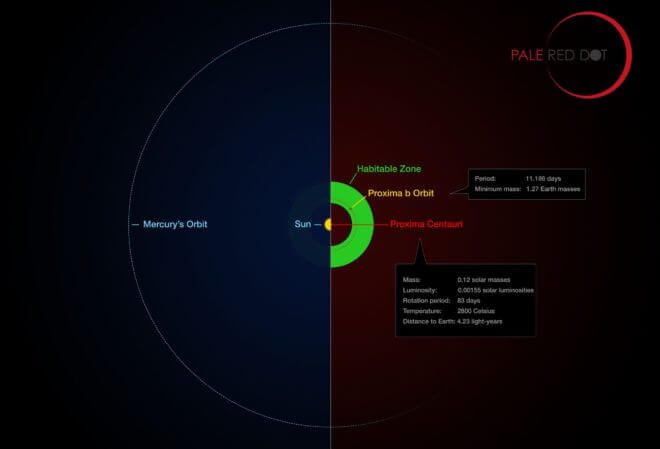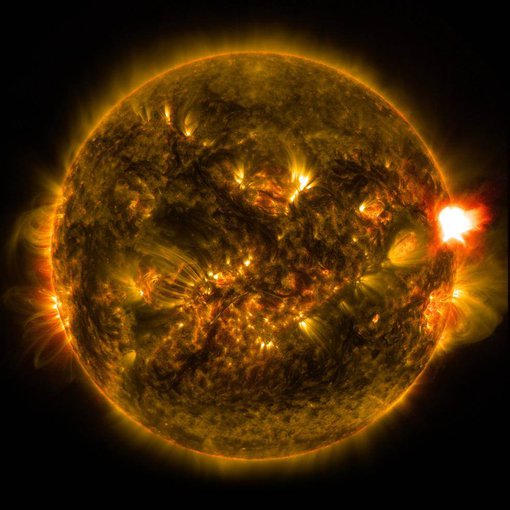
In 2016, the La Silla Observatory in Chile spotted evidence of possibly the most eagerly anticipated exoplanet in the Galaxy. It was a world orbiting the nearest star to the sun, Proxima Centauri, making this our closest possible exoplanet neighbour. Moreover, the planet might even be rocky and temperate.
Proxima Centauri b had been discovered by discerning a periodic wobble in the motion of the star. This revealed a planet with a minimum mass 30% larger than the Earth and an orbital period of 11.2 days. Around our sun, this would be a baking hot world.
But Proxima Centauri is a dim red dwarf star and bathes its closely orbiting planet in a level of radiation similar to that received by the Earth. If the true mass of the planet was close to the measured minimum mass, this meant Proxima Centauri b would likely be a rocky world orbiting within the habitable zone.

Artist’s impression of the exoplanet Proxima Centauri b.Image credit: ESO/M. Kornmesser.
Sitting 4.2 light years from our sun, a journey to Proxima Centauri b is still prohibitively long.
But as our nearest neighbor, the exoplanet is a prime target for the upcoming generation of telescopes that will attempt to directly image small worlds. Its existence was also inspiration for privately funded projects to develop faster space travel for interstellar distances.
Yet observations taken around the same time as the La Silla Observatory discovery were painting a very different picture of Proxima Centauri. It was a star with issues.
This set of observations were taken with Evryscope; an array of small telescopes that was watching stars in the southern hemisphere. What Evryscope spotted was a flare from Proxima Centauri that was so bright that the dim red dwarf star became briefly visible to the naked eye.
Flares are the sudden brightening in the atmosphere of a star that release a strong burst of energy. They are often accompanied by a large expulsion of plasma from the star known as a “coronal mass ejection”. Flares from the sun are typically between 1027 – 1032 erg of energy, released in a few tens of minutes.
For comparison, a hydrogen bomb releases the equivalent of about 10 megatons of TNT or a mere 4 × 1023 erg. Hitting the Earth, energy from solar flares and coronal mass ejections can disrupt communication equipment and create a spectacular aurora.

Comparison of the orbit of Proxima Centauri b with the same region of the solar system. Proxima Centauri is smaller and cooler than the sun and the planet orbits much closer to its star than Mercury. As a result it lies well within the habitable zone.Image credit: ESO/M. Kornmesser/G. Coleman.
But the Proxima super-flare spotted by Evryscope was well beyond a regular stellar flare.
On March 18 in 2016, this tiny red dwarf emitted an energy belch of 1033.5 erg. The flare consisted of one major event and three weaker ones and lasted approximately one hour, during which time Proxima Centauri became 68 times brighter.
A sudden, colossal increase in the brightness of a star does not bode well for any closely orbiting planets.
However, such a major flare might well be rare. If the star was normally fairly quiet, perhaps a planet could recover from a single very disruptive flare in the same way the Earth has survived mass extinction events.
Led by graduate student Ward Howard at the University of North Carolina, Chapel Hill, the discovering team used Evryscope to monitor Proxima Centauri for flares for a total of 1344 hours between January 2016 and March 2018. What they found was a horrifying environment, as reported in The Astrophysical Journal Letters.
While an event on the scale of the Proxima super-flare was only seen once, 24 large eruptions were spotted from the red dwarf, with energies from 1030.5 to 1032.4 erg. Allowing for the fact the star had only been observed for a small part of the year, this pattern of energy outbursts meant that a massive super-flare (1033 erg) was likely to occur at least five times annually.

A solar flare erupting from the right side of the sun.Image credit: NASA/SDO.
But how important is this for the planet?
The Earth is protected from flares from our sun by our atmosphere. The ozone layer absorbs harmful ultraviolet radiation with wavelengths between about 2400 – 2800 Angstroms (10-10 m), preventing it reaching the surface. So what if Proxima Centauri b had a similar protective layer of gases as the Earth?
To answer this question, Howard and his team ran simulations of an Earth-like atmosphere on Proxima Centauri b.
As is the case for the sun, the team assumed that large flares would be frequently accompanied by a coronal mass ejection. Radiation and stellar material then flooded over an Earth-like Proxima Centauri b at the observed rate. And the atmosphere crumbled.

Artist’s impression of the surface of the planet Proxima Centauri b. But what would conditions be like so close to a flaring star?Image credit: ESO/M. Kornmesser.
High energy particles in the coronal mass ejections split the nitrogen molecules (N2) in the atmosphere, which reacted with the ozone (O3) to form nitrogen oxide (NO2). After just 5 years, 90% of the ozone in the atmosphere was lost and the amount was still decreasing.
Without ozone, the surface of Proxima Centauri b would be stripped of its protection from UV radiation. During the Proxima super-flare, the radiation dose without the protective ozone would be 65 times larger than that needed to kill 90% of one of the most UV-resilient organisms on Earth.
“Life would have to undergo extreme adaptation to UV or exist underground or underwater,” Howard notes. “Only the most resistant organisms could survive on the surface in this environment.”
The simulation does assume that Proxima Centauri b does not have a magnetic field. Such a shield could channel the particles from the coronal mass ejection to the poles, forming the aurora as on Earth and reducing the damage to the atmosphere.
However, orbiting so close to the star, Proxima Centauri b is likely to be in tidal lock as the moon is to the Earth. This is expected to weaken the magnetic field, as the slower rotation makes it harder to create a magnetic dynamo within the planet.
So if the protective shields are lowered on Proxima Centauri b, is our nearest planet a world populated by highly resistant UV organisms? Or have we seen evidence that rather than warming the planet to allow life to exist, this star has snuffed it out?
